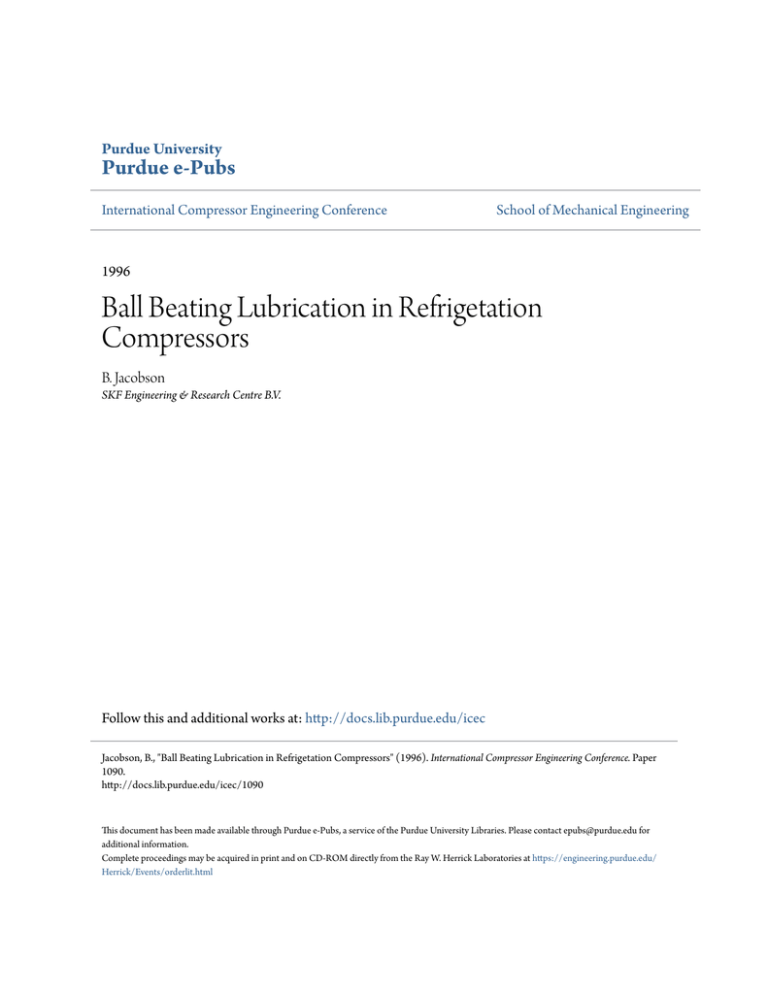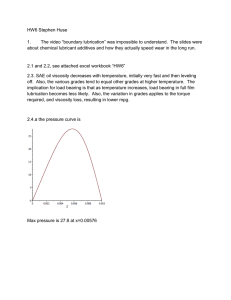Ball Beating Lubrication in Refrigetation - Purdue e-Pubs
advertisement

Purdue University Purdue e-Pubs International Compressor Engineering Conference School of Mechanical Engineering 1996 Ball Beating Lubrication in Refrigetation Compressors B. Jacobson SKF Engineering & Research Centre B.V. Follow this and additional works at: http://docs.lib.purdue.edu/icec Jacobson, B., "Ball Beating Lubrication in Refrigetation Compressors" (1996). International Compressor Engineering Conference. Paper 1090. http://docs.lib.purdue.edu/icec/1090 This document has been made available through Purdue e-Pubs, a service of the Purdue University Libraries. Please contact epubs@purdue.edu for additional information. Complete proceedings may be acquired in print and on CD-ROM directly from the Ray W. Herrick Laboratories at https://engineering.purdue.edu/ Herrick/Events/orderlit.html BALL BEARING LUBRICATION IN REFRIGERATION COl\fPRESSORS Bo Jacobson SKF Engineering & Research Centre B. V. Postbus 2350,34 30 DT Nieuwegein, The Netherlands e-mail SESKFHE5@IHMMA1L.COM ABSTRACT When the re:fiigerant R l34a is mixed with an ester oil and usea m compressor bearing lubrication, no EP action is experienced. The refrigerant contains no chlorine and the lubricant additives can not be chemically active like normal EP additives, not to deposit in and destroy the heat excha..>Jgers. The iubricant film thickness thus needs to be considerably larger for an Rl34a compressor bearing than for e.g. an R22 compressor bearing if the same service life should be expected for the two bearings. Typically 50% higher viscosity was needed for the R134a mixture to get a certain wear rate compared to ail R22 mixture giving the same wear rate. To avoid the problem with high wear rate at high re:fiigerant concentrations and to make it possible to run the compressor bearings with less oil an experimental investigation was performed. The experim ents investigated the possibility to locally increase the oil concentration at the elastohydrodyna mic contacts in the bearings to get better lubrication. INTRODUCTION The increasing demands for more environmentally safe refiigeration processes and machine s have led to the adoption of a number of new re:fiigerants and refrigerant mixtures to fulfil the thermodynamic requirements for the refiigeration cycles. When chloro fluoro carbon refrigera nts were used in compressors, the chlorine in the molecules functioned as an EP additive . The lubricated surfaces could often not be separated by a continuous lubricant film due to the very low viscosity of the oil-refrigerant mixture, but the chlorine made it possible to get a controlled running in of the surfaces leading to lower surface roughness and better separation of the surfaces . The bearing surfaces reached a stable smooth state after some running time. Many of the new refiigerants do not easily mix or dissolve in mineral oils and can thus not be used togethe r with the lubricants earlier used for e.g. Rll, Rl2 and R22 refri.geration systems. The solubility and the rate at which refrigerants can be dissolved in the lubricant and also how fast they can be released from the lubricant determine the state of the lubrication at each position in a compressor. As the oil-refrigerant mixture circulates through the different parts of the compres sor and the refiigeration circuit, there are different time delays between the local pressure-temperature-state and the equilibrium pressure-temperature-state depending on the lubricant type and the refrigerant type. The old systems with CFC:s and mineral oils have very rapid response with fast dissolution in and a fast release from the oil of refrigerant when the pressure is changed. 103 With the synthetic esters developed for lubrication of Rl34a compressors the response time can be chosen more or less freely depending on the requirements. The problem is that the requirements for the compresso r and the requirements for the heat exchangers are pointing in quite opposite directions. The compresso r lubrication works best when the lubricant contains only a small percentage refiigerant i.e. the solubility of refrigerant in the oil should be low. But this low solubility will result in difficulties to retrieve any of the oil deposited ·in the heat exchangers. It: on the other hand, the solubility of refrigerant in the lubricant is high, oil in the heat exchangers will be brought back to the compresso r by the refrigerant flow but this also leads to problems with separation of the refrigerant from the lubricant at the bearing positions. It will be difficult to reach a high enough oil concentration to get good lubrication of the compressor bearings. There are thus two possible remedies for this problem if the refrigeration heat exchangers are not going to be adversely effected: Locally at the bearings increase the oil concentration so a high enough viscosity is reached or keep the low oil concentration but make the bearings less vulnerable to too low viscosity. LOCAL OIL CONCENTRATION The total volume of lubricant at each instance of time being kept in the load carrying oil film in a bearing is extremely small. For a heavily loaded bearing of the type 6309 (deep groove ball bearing with inner diameter 45 mm and outer diameter 100 mm) the total Hertzian contact area 2 between the balls and the rings is about 25 mm and if the mean oil film thickness is 0.4 Jlm the 3 total load carrying oil volume is 0.01 mm . This means that even if the oil concentration in the 3 refrigerant is as low as 1 %, only 1 mm of that mixture needs to be evaporated to leave enough oil on the bearing surfaces for good lubrication_ This can be done locally at the bearing by local heating or by the bearing power loss as described by Wardle et al. [1,2]. At the present time, most refrigeration systems utilize two partially miscible fluids; a refrigerant for heat transfer, and a lubricant for lubricating machine elements in the compressor. Compressors typically have a separate sump, pumping means, and distribution system for the lubricating oil, all isolated, but not sealed from the refiigerant. Pressure, temperatur e and mechanical separation means are employed to maintain a sufficiently oil rich mixture in the sump for reliable lubrication, typically no more than 20% refrigerant by weight. Refiigeration systems are also designed to limit the amount of oil discharged into the heat transfer devices, such as the evaporator, to avoid fouling and associated loss of system efficiency. Solubility characteristics between the fluids are tailored to minimize the amount of dissolved refiigerant in the oil sump, yet provide sufficient solubility in the evaporator, condenser, and intercoiUlecting piping to assure oil leaving the compresso r returns via entrainment in the circulating refiigerant. The need to maintain an oil rich fluid in the sump, and limit the build-up of oil in the evaporator, over the wide range of operating conditions common in refiigeration systems, usually necessitates complex and costly control systems and fluid separation features. Loss of control of the two fluids during extreme system operating conditions is a common cause of compresso r failures, particularly compresso r bearing failures, due to excessive refrigerant build-up in the sump. For these reasons, efforts have been directed to elimination of the need for oil separation, and to 104 use the refrigerant rich lubricating fluids naturally residing in the evapo rator or conde nser for lubrication purposes. The invention, described in [1,2] provides a means of reliably lubrica ting rolling bearin gs in refrigerant compr essors wid1 refrigerant/oil mixtures which would nonna lly have inadeq uate viscosity for such purposes. It has been discovered that, generally speaking, mixtures containing less than about 75% oil by weight can not sustain an oil film in rolling element bearings and therefore are unsuitable for lubrication purposes. In conflict with this requirement is the need to restrict oil concentration to 5% or less in the heat exchangers of a refrigeration system. The presence of oil in a heat exchanger negatively affects heat transfe r and overall system efficiency. The invention, described in [1,2], provides a means for using a refrigerant rich mixture communicated from either an evapo rator or condenser, to lubricate rolling element bearings by a process which concen trates the oil to a level suitable for the lubrica tion of such bearings. The concentration of oil is achieved by movement of the mixture !nto the two phase region of its pressure-enthalpy region to release an oil rich fluid for lubrication purpos es on the bearing. Bearin g frictional heat plays a significant role in the enrichment proces s if flow rates are limited to the low levels typical of spot or mist lubrication methods. At such low flow rates, bearing friet.ional heat, or bearing frictional heat combined with reduction of pressure, is sufficient to evapo rate the refrigerant. The principal advan tage of the invention, described in [1,2], is that the use of lubricating fluids naturally residing in either a low pressure evapo rator or a high pressu re conde nser avoids the need for expensive and complicated mechanical oil separators, and avoids the need for a separa te oil sump and associated sealing elements. This is particularly true in screw compressors using liquid refrigerant injection instead of oil injection to cool and seal the compr ession process since an oil separa tor wou1d only be needed for bearing lubrication. Anoth er advantage is that significantly reduced bearing friction is achieved due to low oil flow which may be as low as that used in spot or mist lubrication. The invention, described in [1,2], requires that tempe rature , pressu re and flow rate for the mixture be controlled to accomplish the vapori zation of refrigerant from the mixture and the deposition of the remaining oil on the bearing. Prope r contro l of these variables will insure good lubrication. By electrically measuring the oil film build-up in a test bearing, the bearing speed neede d for surface separa tion at different bearing outer ring tempe rature s and different refrigerant . gas pressures was registered, see Figure 1. For each given outer ring tempe rature a higher pressu re gives a higher refrigerant concentration, see Figure 2, but for a consta nt pressure a higher tempe rature gives a lower refrigerant concentration in the lubricant. This leads to the surprising result that if the tempe rature is increased at constant pressure, so much refrigerant boils off from the mixture that the viscosity of the mixture actually increases when the tempe rature increases. This is clearly seen in Figure 1, where for all gas pressu res the speed needed for good lubrication decreases when the tempe rature increases. It is thus advan tageou s to have the bearing at a high tempe rature to boil off as much refrigerant as possible from the lubrica nt mixture. To boil off as 105 nt high a percentage of the refrigerant flow as possible with a certain available power, the refrigera at oil ester flow should be minimized. Tests were run with 99 percent R134a and 1 percent per minute different flow rates through a ball bearing and only at flow rates below 0.01 gallons -4°. At Vminute) could the power loss in the bearing increase the bearing tempera ture above (0.04 increase the flow rate 0.005 gallons per minute (0.021/nrinute) the power loss gave a tempera ture of go and very good lubrication. bearing · By decreasing the refii.gerant-lubricant flow rate through the bearing, until the small only tempera ture gets so high that the lubricant at that tempera ture and pressure can contain low power amounts of refrigerant, the lubrication will be optimized giving a thick oil film and a loss. LOW WEAR RATE BEARIN GS the If the concentration of refrigerant in the lubricant can not be decrease d below 25 percent, contact oil film thickness will not be large enough to give acceptably low wear rates for the bearing 1994 the in stated already As surfaces in R134a compres sors running at speeds below 6000 rpm. becoming International Compre ssor Engineering Conference at Purdue [3] the wear rate was only with tests in R22 acceptably low at 6000 rpm and 20 percent refiigera nt both for Rl34a and higher angular contact ball bearings. The viscosity of the R134a mixture was then about 50 percent to run at than the viscosity of the R22 mixture showing that the EP action ofR22 makes it posSible a thinner oil film with the same amount of wear. for When the test results .were analysed more in detail, the lubricant film thickness needed in an air acceptably low wear rate was much higher than expecte d for normally lubricat ed bearings was needed environment. For the R22-mineral oil mixture at the bearing position the viscosity The R22 about 3.5 times higher than what should be needed for a bearing surroun ded by air. the bearing atmosphere was not as efficient as air in guiding the running-in and smoothening surfaces. normally The Rl34a-e ster oil mixture was even worse. More than 5 times higher viscosity than ly low predicted for bearings in air atmosph ere was needed to get the wear rate down to acceptab levels. The bearings did not seem to run in at aiL This leads to two conclusions: It will not 1) the bearing type has to have extremely smooth surfaces already from production. run-in and become smooth. can not 2) the whole lubricant-refrigerant system has to be kept clean, so that contaminant particles ed by roughen are be overrolled and destroyi ng the smooth bearing surfaces. If the bearing surfaces wear rolling on particles they wili later not be possible to separate with an oil film and the bearing will be rapid. CONCLUSION t is To get good bearing lubrication also at high concent ration of refriger ant in the lubrican it then Only necessary to dramatically decreas e the flow of oil-refrigerant mixture to the bearings. nt to get is possible for the bearing power loss to boil off a high enough percenta ge of the refrigera 106 high enough viscosity for good lubrication. This makes it possib le to opera te a compressor without a..J. oil separator for bea..-=..ng lubrication. As the lubricant film thickness to sutface rouglu1ess ratio needed for long bearing life in Rl34a compressors is higher than in an air environment, bearings with very smooth surfaces should be chose n and contamination particles in the lubricant should not be allowed to destro y the surfaces. REFERENCES [1] US patent 08/184861 [2] European paten t application 95200 132.9 [3] Jacobson, Bo, "Lubrication of Screw Comp ressor Beari ngs in the Presence ofRef ugera nts", Proc. Vol. 1, 1994 International Comp resso r Engineering Confe rence at Purdue, pp. J. 15-120 FIGU RES 70000 \ i 60000 l\ \\ "0 Q) Q) g.~ 50000 -o 40000 ::; 30000 oz ....... - 20000 "" ~ '- \'-.. ~ 0 0 5 1\.. ~ ~ r--_ -~------ l---- 10000 \ -- ~ 1"---.. "--r--...~ Pressure 5.15 Bar Pressure 4.46 Bar I PressureI 3.77 Bar Pressure 3.08 Bar r-- - I I I 10 15 20 25 30 Bearing outer ring temperature, oc 35 40 Fig. 1 Bearing lift-off speed (rpm x bearing mean diameter in mm) as a function of refrigerant gas pressu re and bearing outer ring temperature. 107 1 I -20 Fig. 2 0 80 60 40 20 cc ture, pera Tem 100 The refrigerant gas pressure-percentage dilution of refrigerant in relationship. 108 I I I 140 the lubricant-temperature

